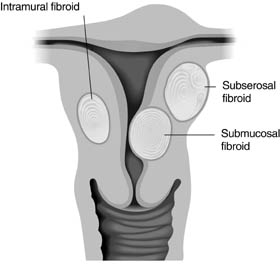Uterine Fibroids

Uterine fibroids are very common non-cancerous (benign) growths that develop in the muscular wall of the uterus. They can range in size from very tiny (a quarter of an inch) to larger than a cantaloupe. Occasionally, they can cause the uterus to grow to the size of a five-month pregnancy. In most cases, there is more than one fibroid in the uterus. While fibroids do not always cause symptoms, their size and location can lead to problems for some women, including pain and heavy bleeding.
Fibroids can dramatically increase in size during pregnancy. This is thought to occur because of the increase in estrogen levels during pregnancy. After pregnancy, the fibroids usually shrink back to their pre-pregnancy size. They typically improve after menopause when the level of estrogen, the female hormone that circulates in the blood, decreases dramatically. However, menopausal women who are taking supplemental estrogen (hormone replacement therapy) may not experience relief of symptoms.
Uterine fibroids are the most common tumors of the female genital tract. You might hear them referred to as "fibroids" or by several other names, including leiomyoma, leiomyomata, myoma and fibromyoma. Fibroid tumors of the uterus are very common, but for most women, they either do not cause symptoms or cause only minor symptoms.
Subserosal Fibroids

These develop under the outside covering of the uterus and expand outward through the wall, giving the uterus a knobby appearance. They typically do not affect a woman's menstrual flow, but can cause pelvic pain, back pain and generalized pressure. The subserosal fibroid can develop a stalk or stem-like base, making it difficult to distinguish from an ovarian mass. These are called pedunculated. The correct diagnosis can be made with either an ultrasound or magnetic resonance (MR) exam.
Intramural Fibroids
These develop within the lining of the uterus and expand inward, increasing the size of the uterus, and making it feel larger than normal in a gynecologic internal exam. These are the most common fibroids. Intramural fibroids can result in heavier menstrual bleeding and pelvic pain, back pain or the generalized pressure that many women experience.
Submucosal Fibroids
These are just under the lining of the uterus. These are the least common fibroids, but they tend to cause the most problems. Even a very small submucosal fibroid can cause heavy bleeding - gushing, very heavy and prolonged periods.
Prevalence of Uterine Fibroids
Twenty to 40 percent of women age 35 and older have uterine fibroids of a significant size. African American women are at a higher risk for fibroids: as many as 50 percent have fibroids of a significant size. Uterine fibroids are the most frequent indication for hysterectomy in premenopausal women and, therefore, are a major public health issue. Of the 600,000 hysterectomies performed annually in the United States, one-third are due to fibroids.
Uterine Fibroid Symptoms
Most fibroids don't cause symptoms-only 10 to 20 percent of women who have fibroids require treatment. Depending on size, location and number of fibroids, they may cause:
- Heavy, prolonged menstrual periods and unusual monthly bleeding, sometimes with clots. This can lead to anemia.
- Pelvic pain and pressure
- Pain in the back and legs
- Pain during sexual intercourse
- Bladder pressure leading to a frequent urge to urinate
- Pressure on the bowel, leading to constipation and bloating
- Abnormally enlarged abdomen
Treatments include Uterine Fibroid Embolization (UFE) and Magnetic Resonance Guided Focused Ultrasound.


